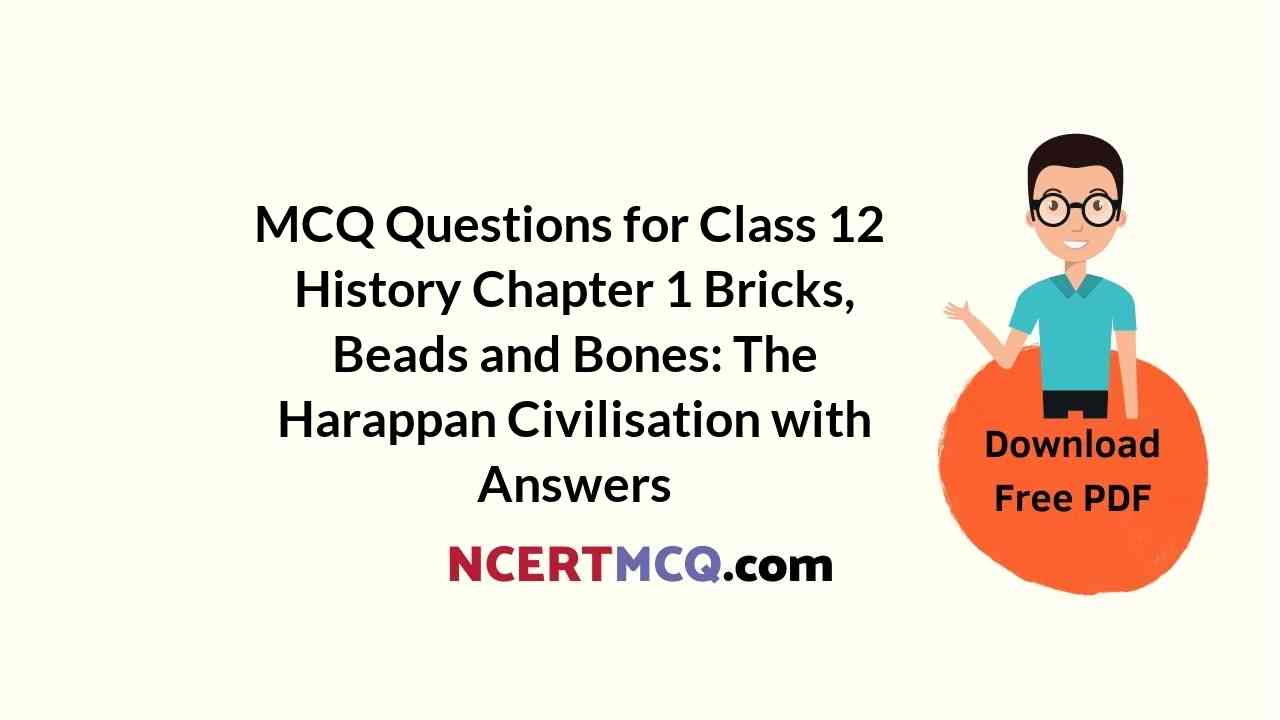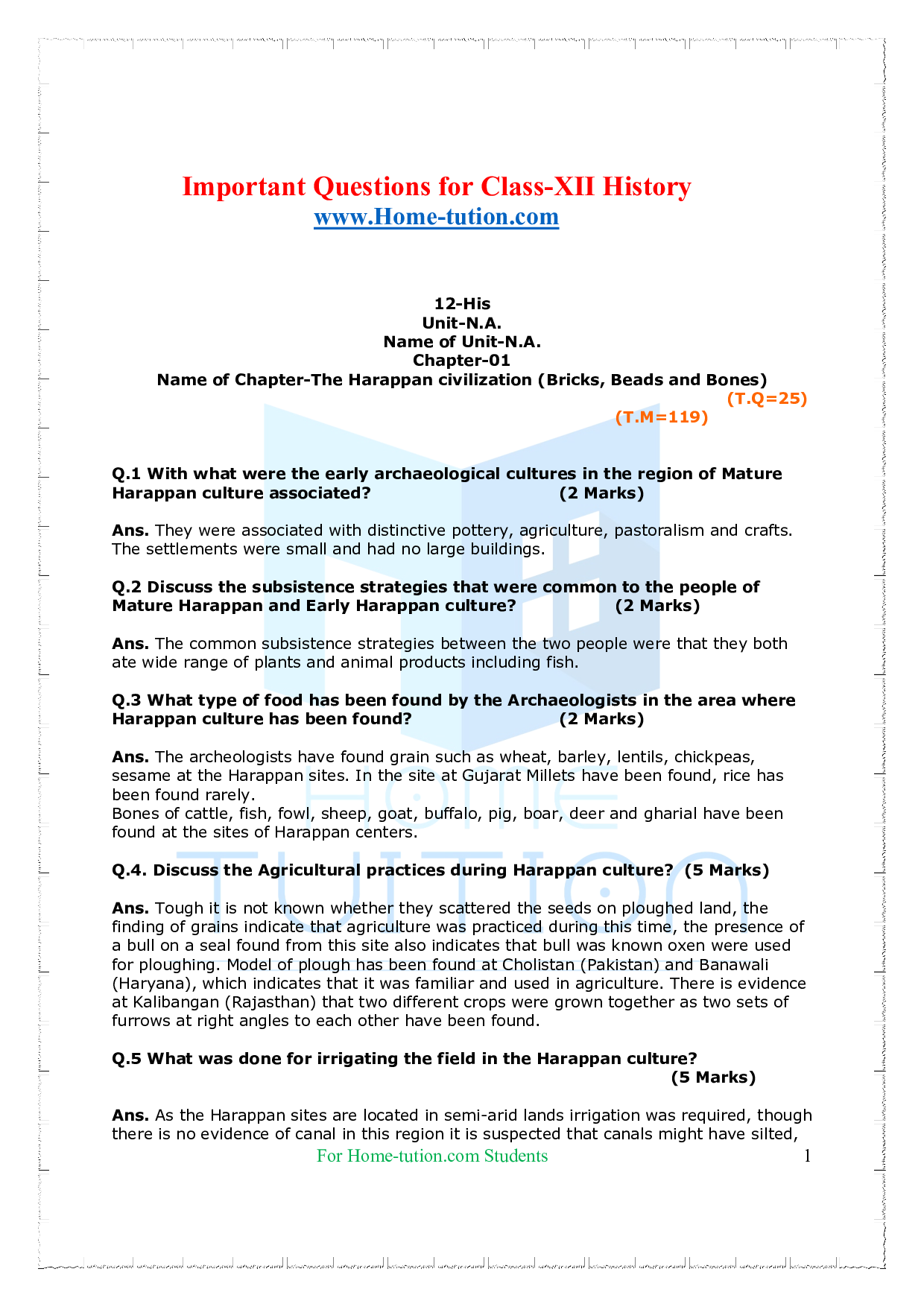
the harappan civilization (bricks beads and bones) hs 2nd year important questions and notes
C12 History Theme1 Bricks, Beads, and Bones MCQs. Please read the instructions carefully before the test. 1. All the students must take note of the time because the time is limit is 45 minutes. 2. Attempt all the Questions. 3. Each MCQ carries 1 mark and each fill-up carries 2 marks. Sign in to Google to save your progress.

MCQ Questions for Class 12 History Chapter 1 Bricks, Beads and Bones The Harappan Civilisation
Important Questions and Answers. 1 mark Questions; 2 marks Questions; 3 marks Questions; 4 marks Questions; History - Part I. Chapter / Theme 1 : Bricks, Beads and Bones - The Harappan Civilisation; Chapter / Theme 2: Kings, Farmers and Towns : Early States and Economies; Chapter / Theme 3 : Kinship, Caste and Class - Early Societies

MCQ Question (Quiz) For Class 12, History, Chapter 1 Bricks Beads And Bones CBSE Topper Best
Bricks, Beads and Bones | NCERT Class 12 History | Chapter 1 | Most Important Questions 👉🏻Ask Your Doubts🤷♀️ & Directly Connect With Teachers : https://forms.gle/TvHZaf8iGap7otfA8.

Most Important Question Bricks, Beads and Bones NCERT Ch 1 History 202223 Ajay Dhayal
Bricks, Beads and Bones. In this post, we have given the detailed notes of Class 12 History Chapter 1 (Bricks, Beads and Bones) in English. These notes are useful for the students who are going to appear in class 12 board exams.. Class 11 All Important Questions; Class 11 All Important Quizzes; Class 11 All Important Objective Questions.

Class 12, Chapter 1, BRICKS BEADS AND BONES explanation from NCERT /Introduction/Part 1 of
Question 1. Which of these is the other name of Harappan Civilisation? (a) Aryan Civilisation (b) Indus Valley Civilisation (c) Vedic Civilisation (d) All of these Answer Question 2. Which of these sites of Harappan Civilisation belong to Haryana? (a) Kalibangan (b) Lothal (c) Banawali (d) Shortugai Answer Question 3.

MCQ Bricks, Beads and Bones PART 3 bricks beads and bones class 12 mcq questions YouTube
Question 1. Bones of which animals were found at Harappan sites? Answer: Cattle, sheep, goat, buffalo and pig. Question 2. At which sites the terracota models of the plough have been found? Answer: At Cholistan and Banawali Haryana. Question 3. At which Harappan site, traces of canals have been found? Answer: At Shortugai in Afghanistan.

Bricks Beads and Bones Class 12 History Class 12 History Chapter 1 By Anita maam Part 2
Answer Yes, I agree with that the drainage system in Harappan cities which indicates the town planning can cite the following reasons in support of my answer. (i) Bricks, sundried or baked were of standard ratio. The length and breadth of bricks were of four times and times and twice the height respectively.

Class 12 History Ch 1 Bricks, Beads and Bones Most Important Questions Inten, Manke or Asthiya
Answer: Cunningham. Question: The longest signs containing inscription contains how many signs? Answer: 26 Signs Short Answer Questions : Question: How can you say that the Harappan culture was an urban one? Answer:- The cities were well planned into upper and lower town. - The roads were straight and wide.

Ch1 Bricks, Beads and bones.. 8 mark important Que ans CBSE last 10 years Questions YouTube
The most important industry of the Harappans at Chanhudaro was (a) Bead-making (b) Brick making (c) Handlooms (d) Ship building (a) Bead-making 5. The Director General of the ASI who brought a military precision to the practice of archaeology was (a) Cunningham (b) Hargreaves (c) James Burgess (d) R.E.M. Wheeler (d) R.E.M. Wheeler

NCERT CLASS 12 history Chap 1 bricks, beads and bones Important Question & Answer
Bricks Beads and Bones Class 12 Most Important Questions Board Exam 2023 The Twin Bros - Humanities 34.8K subscribers Join Subscribe Subscribed 862 19K views 1 year ago History Most.

Bricks, beads and bones class 12 history chapter 1 detailed explanation Harappan
Most Important Questions: Bricks, Beads and Bones | History Class 12 | The Twin BrosPDF- https://drive.google.com/file/d/1ZCoTQZJKi9eL2HFtjI_h-gYIlQ8Qehtx/vi.

Bricks beads and bones class 12 HistoryClass 12 History Chapter 1Detailed Explanation YouTube
Class 12th History important questions in chapter 1 Bricks breads and bones for free download in PDF format. The most important questions for annual examination from chapter 1 Bricks breads and bones are given here for download. The additional questions for practice from XII class CBSE exam are collected from various sources.

BRICKS BEADS AND BONES REVISION 10 मिनट में CLASS 12 HISTORY MOST IMPORTANT QUESTIONS WITH
Question 1. Who was John Marshall? How did he mark a change in the Indian archaeology? (Delhi 2016) Answer: John Marshall was the Director-General of the Archaeological Survey of India. His contribution in the Indian Archeology can be understood by the following points: He announced the discovery of new civilization i.e. Indus valley civilization.

Bricks Beads and Bones Class 12 Most Important Questions Board Exam 2023 YouTube
1. It was pictographic in nature as the script consisted of designs of animals,fishes and various forms of human figure too. 2. It was found to be inscribed on seals, terracota tablets, etc. Q 3 - What were the differences in the techniques adopted by Marshall and Wheeler in studying Harappan civilization?

Important Questions For Class 12 History Chapter1 Bricks, Beads and Bones The Harappan civilisation
Question 1. Bones of which animals were found at Harappan sites? Answer: Cattle, sheep, goat, buffalo and pig. Question 2. At which sites the terracota models of the plough have been found? Answer: At Cholistan and Banawali Haryana. Question 3. At which Harappan site, traces of canals have been found? Answer At Shortugai in Afghanistan. Question 4.

Bricks Beads and Bones Notes
rcheological Evidences of The Harappan Civilisation: The Harappan Civilisation is also known as Indus Valley Civilisation. This civilisation is dated between BCE 2600 and 1990 BCE. It is the oldest civilisation of India. We know about the civilisation from archaeological evidences like houses, pots, ornaments, tools and seals used by the people.